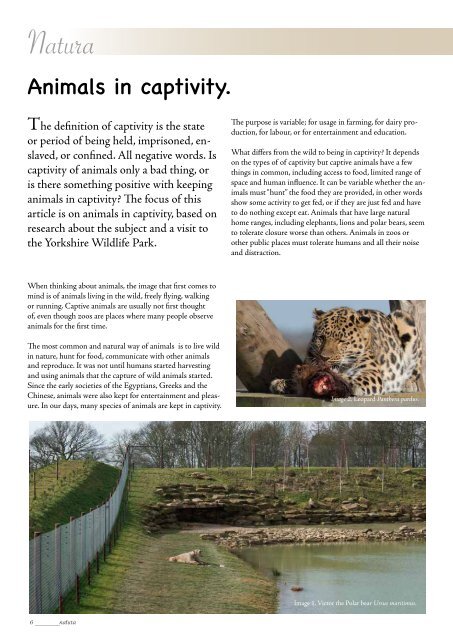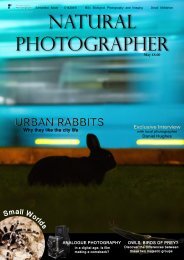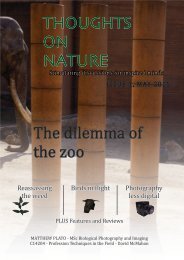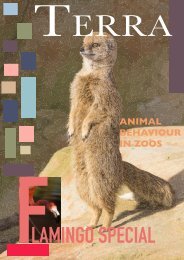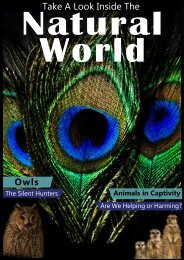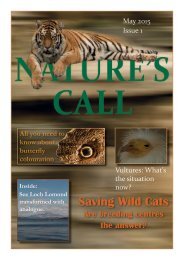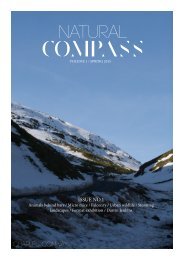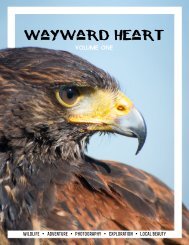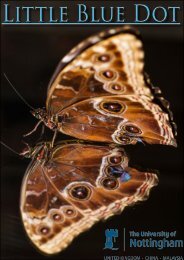NATURA
You also want an ePaper? Increase the reach of your titles
YUMPU automatically turns print PDFs into web optimized ePapers that Google loves.
Natura<br />
Natura<br />
Animals in captivity.<br />
The definition of captivity is the state<br />
or period of being held, imprisoned, enslaved,<br />
or confined. All negative words. Is<br />
captivity of animals only a bad thing, or<br />
is there something positive with keeping<br />
animals in captivity? The focus of this<br />
article is on animals in captivity, based on<br />
research about the subject and a visit to<br />
the Yorkshire Wildlife Park.<br />
When thinking about animals, the image that first comes to<br />
mind is of animals living in the wild, freely flying, walking<br />
or running. Captive animals are usually not first thought<br />
of, even though zoos are places where many people observe<br />
animals for the first time.<br />
The most common and natural way of animals is to live wild<br />
in nature, hunt for food, communicate with other animals<br />
and reproduce. It was not until humans started harvesting<br />
and using animals that the capture of wild animals started.<br />
Since the early societies of the Egyptians, Greeks and the<br />
Chinese, animals were also kept for entertainment and pleasure.<br />
In our days, many species of animals are kept in captivity.<br />
The purpose is variable; for usage in farming, for dairy production,<br />
for labour, or for entertainment and education.<br />
What differs from the wild to being in captivity? It depends<br />
on the types of of captivity but captive animals have a few<br />
things in common, including access to food, limited range of<br />
space and human influence. It can be variable whether the animals<br />
must “hunt” the food they are provided, in other words<br />
show some activity to get fed, or if they are just fed and have<br />
to do nothing except eat. Animals that have large natural<br />
home ranges, including elephants, lions and polar bears, seem<br />
to tolerate closure worse than others. Animals in zoos or<br />
other public places must tolerate humans and all their noise<br />
and distraction.<br />
Image 2. Leopard Panthera pardus.<br />
Stereotypic animal behaviour is when animals repeat abnormal<br />
behaviour. It can be all kinds of behaviour, for example<br />
walking, shaking or blinking. What causes this activity is not<br />
known, but it is common among animals in captivity. One<br />
theory is that this is a way of coping with being in captivity.<br />
In nature many animals need to hunt their own prey, often<br />
running and using a lot of energy. In captivity the release of<br />
energy can often be difficult, causing the animals to behave<br />
in a way to reduce this unused energy. Others suggest that<br />
this is a brain dysfunction caused by stress. Not necessarily<br />
a stress at the time when the behaviour is conducted, but<br />
possibly because of a former stress; a scar from the past.<br />
One type of stereotypic behaviour is constantly and repeatedly<br />
walking the same trail, resulting in paths in the ground. In<br />
Yorkshire Wildlife Park this was obvious for a number of animals,<br />
such as the leopards and the lions. Many behavioural<br />
types not seen<br />
in the wild have<br />
been registered<br />
for animals<br />
in captivity,<br />
for example<br />
hair plucking,<br />
bar biting,<br />
neck twisting,<br />
vomiting and<br />
self mutilation.<br />
Image 3. Leopard Panthera pardus.<br />
Image 5. Zebra Equus quagga. [Non-marked]<br />
Image 4. Ankole-Watusi, also known as Ankole longhorn with latin name Bos taurus. Native on the<br />
savannas and open grasslands in Africa. Here feeding in Yorkshire Wildlife Park. [Non-marked]<br />
6 _____natura<br />
Image 1. Victor the Polar bear Ursus maritimus.<br />
natura_____7


